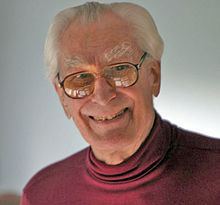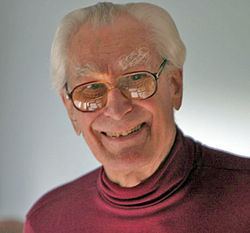Name Richard Guy Role Mathematician | Children Michael Guy | |
 | ||
Books Unsolved problems in number theory, The Inquisitive Problem Solver Similar People John Horton Conway, Peter J Bentley, Gordon Wenham, Kenneth Falconer | ||
Education University of Cambridge | ||
Richard K. Guy's Conjecture IS A THEOREM!!!
Richard Kenneth Guy (born 30 September 1916) is a British mathematician, professor emeritus in the Department of Mathematics at the University of Calgary. He is known for his work in number theory, geometry, recreational mathematics, combinatorics, and graph theory. He is best known for co-authorship (with John Conway and Elwyn Berlekamp) of Winning Ways for your Mathematical Plays and authorship of Unsolved Problems in Number Theory. He has also published over 300 papers. Guy proposed the partially tongue-in-cheek "Strong Law of Small Numbers," which says there are not enough small integers available for the many tasks assigned to them – thus explaining many coincidences and patterns found among numerous cultures. For this paper he received the MAA Lester R. Ford Award.
Contents
- Richard K Guys Conjecture IS A THEOREM
- Numbers Pictures and Richard Guy The Leaning Tower of Pingala Richard K Guy
- Early life
- The war years
- 1950s to present
- Mathematics
- Chess problems
- Books
- References

Numbers, Pictures, and Richard Guy & The Leaning Tower of Pingala – Richard K Guy
Early life
Guy was born 30 September 1916 in Nuneaton, Warwickshire, England, to Adeline Augusta Tanner and William Alexander Charles Guy. Both of his parents were teachers, rising to the rank of headmistress and headmaster, respectively. He attended Warwick School for Boys, the third oldest school in Britain, but was not enthusiastic about most of the curriculum. He was good at sports, however, and excelled in mathematics. At the age of 17 he read Dickson's History of the Theory of Numbers. He said it was better than "the whole works of Shakespeare." His future was set. By then he had also developed a passion for mountain climbing.
In 1935 Guy entered Gonville and Caius College, at the University of Cambridge as a result of winning several scholarships. To win the most important of these he had to travel to Cambridge and write exams for two days. His interest in games began while at Cambridge where he became an avid composer of chess problems. In 1938, he graduated with a second-class honours degree; he himself thinks that his failure to get a first may have been related to his obsession with chess. Although his parents strongly advised against it, Guy decided to become a teacher and got a teaching diploma at the University of Birmingham. He met his future wife Nancy Louise Thirian through her brother Michael who was a fellow scholarship winner at Gonville and Caius College. He and Louise shared loves of mountains and dancing. He wooed her through correspondence, and they married in December 1940.
The war years
In November 1942, Guy received an emergency commission in the Meteorological Branch of the Royal Air Force, with the rank of flight lieutenant. He was posted to Reykjavik, and later to Bermuda, as a meteorologist. He tried to get permission for Louise to join him but was refused. While in Iceland, he did some glacier travel, skiing and mountain climbing, marking the beginning of another long love affair, this one with snow and ice. When Guy returned to England after the war, he went back to teaching, this time at Stockport Grammar School, but stayed only two years. In 1947 the family moved to London, where he got a job teaching math at Goldsmiths' College.
1950s to present
In 1951 he moved to Singapore, where he taught at the University of Malaya for the next decade. He then spent a few years at the Indian Institute of Technology in Delhi, India. While they were in India, he and Louise went mountaineering in the foothills of the Himalayas. Guy moved to Canada in 1965, settling down at the University of Calgary in Alberta, where he obtained a professorship. Though he officially retired in 1982, he still goes to the office five days a week to work, even now at the age of 100.
In 1991 the University of Calgary awarded him an Honorary Doctorate. Guy claims that they gave him the degree out of embarrassment, but the university tells it differently saying, "his extensive research efforts and prolific writings in the field of number theory and combinatorics have added much to the underpinnings of game theory and its extensive application to many forms of human activity." Guy and his wife Louise (who died in 2010) remained very committed to mountain hiking and environmentalism all their lives. In 2014, he donated $100,000 to the Alpine Club of Canada for the training of amateur leaders. The Alpine Club has in turn honoured them by building the Louise & Richard Guy Hut near the base of Mont des Poilus. He has three children, among them computer scientist and mathematician Michael J. T. Guy.
Mathematics
While teaching in Singapore in 1960 Guy met the Hungarian mathematician Paul Erdős. Erdős was noted for posing and solving difficult mathematical problems and shared several of them with Guy. Guy says, "I made some progress in each of them. This gave me encouragement, and I began to think of myself as possibly being something of a research mathematician, which I hadn't done before." Eventually he wrote four papers with Erdős, giving him an Erdős number of 1. He even solved one of Erdős' problems. Guy has always been intrigued by unsolved problems and has written two books devoted to them. Many number theorists got their start trying to solve problems from Unsolved problems in number theory.
Guy describes himself as an amateur mathematician but he is more than that. In a career that spans eight decades he has written or co-authored over a dozen books and collaborated with some of the great mathematicians of the 20th century. Paul Erdős, John H. Conway, Donald Knuth, and Martin Gardner are among his collaborators, as are Elwyn Berlekamp, John L. Selfridge, Kenneth Falconer, Frank Harary, Lee Sallows, Gerhard Ringel, Béla Bollobás, C. B. Lacampagne, Bruce Sagan, and Neil Sloane.
Guy is one of the key people in the field of recreational mathematics. In 1998 Martin Gardner wrote, "Conway later collaborated with fellow mathematicians Richard Guy and Elwyn Berlekamp on what I consider the greatest contribution to recreational mathematics in this century, a two-volume work called Winning Ways." In fact, Guy was briefly considered as a replacement for Gardner when the latter retired from the Mathematical Games column at Scientific American. Along with Bill Gosper, Guy has been one of the principal researchers in John H. Conway's Game of Life, and in 1970 discovered the glider, one of the key discoveries in that field. Around 1959, Guy discovered a unistable polyhedron having only 19 faces; no such construct with fewer faces was found until 2012. As of 2016 Guy is still very active mathematically. To mark his 100th birthday friends and colleagues organised a celebration of his life and a tribute song and video was released by Gathering 4 Gardner.
Chess problems
From 1947 to 1951 Guy was the endings editor for the British Chess Magazine. He is known for almost 200 endgame studies. Along with Hugh Blandford and John Roycroft, he is one of the inventors of the GBR code (Guy–Blandford–Roycroft code), a system of representing the position of chess pieces on a chessboard. Publications such as EG magazine use it to classify endgame types and to index endgame studies.
Solution:
1. Ke1-d1 Ka4-a3
2. Kd1-c1 a6-a5
3. h3-h4 a5-a4
4. h4-h5 Ka3-a2
5. h5-h6 a4-a3
6. h6-h7 Ka2-a1
7. h7-h8N underpromotion a3-a2
8. Nh8-g6 f7xg6
9. f6-f7 g6-g5
10. f7-f8N underpromotion g5-g4
11. Nf8-e6 d7xe6
12. d6-d7 e6-e5
13. d7-d8N underpromotion e5-e4
14. Nd8-c6 b7xc6
15. b6-b7 c6-c5
16. Kc1-d1 Ka1-b2
17. b7-b8Q+ wins
